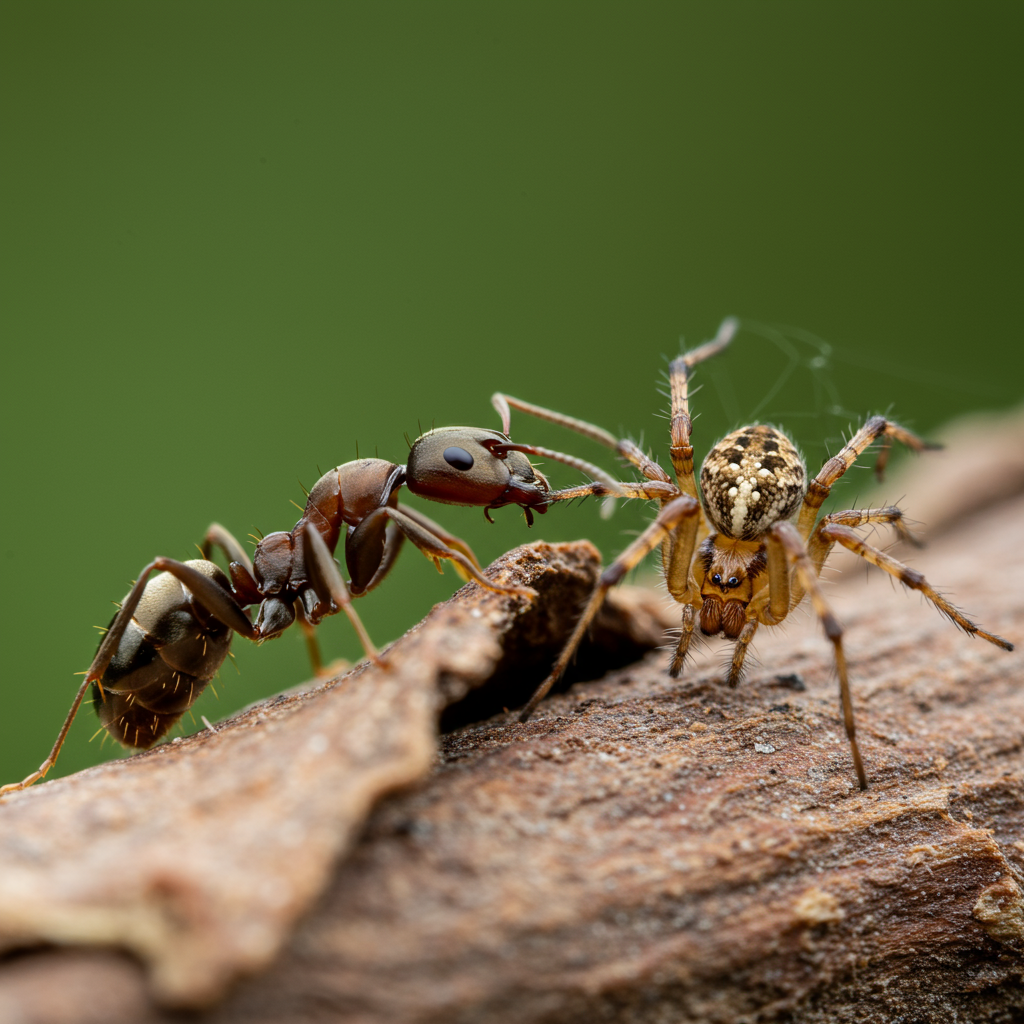Spring bursts forth with vibrant colors and warmer days, drawing us outdoors. We diligently check ourselves and our pets for the usual suspects – fleas and ticks – after enjoying the revitalized landscape. But back inside our homes, a different kind of invasion might be quietly underway. As the ground thaws and temperatures rise, other opportunistic critters also wake up and start looking for resources. Two of the most common, yet often less discussed spring intruders, are ants and spiders. They might not carry the same disease concerns as ticks, but their presence can range from a minor nuisance to a significant problem.
The Ant Armada: Marching In for Spring
Suddenly seeing a trail of tiny ants marching across your kitchen counter is a classic sign of spring’s arrival indoors. Why now? Several factors contribute to this seasonal surge. Ants that overwintered within walls or underground emerge seeking food sources that were scarce during the colder months. Spring rains can also flood existing outdoor nests, forcing colonies to relocate, sometimes choosing the dry, resource-rich environment of your home. They are attracted to the warmth, moisture (especially leaky pipes or damp areas), and, most importantly, food.
Not all ants are created equal when it comes to home invasion. Some of the frequent visitors include:
- Pavement Ants: Small, dark brown to black ants often seen emerging from cracks in sidewalks, driveways, or foundations. They primarily seek out greasy or sweet substances.
- Odorous House Ants: Tiny, dark ants infamous for the rotten coconut smell they emit when crushed. They are drawn to sweets and moisture, often nesting near pipes or in wall voids.
- Carpenter Ants: Larger ants, typically black or reddish-black, that are a more serious concern. Unlike termites, they don’t eat wood, but they excavate it to create smooth galleries for their nests, potentially causing structural damage over time. Finding small piles of sawdust-like material (frass) near wooden structures is a key indicator.
Dealing with an ant invasion effectively often starts with rigorous prevention.
Keeping Ants Out: Your First Line of Defense
The best way to handle ants is to make your home as uninviting as possible. This involves a multi-pronged approach:
Seal Entry Points: Ants are masters at finding tiny openings. Conduct a thorough inspection around your home’s foundation, windows, doors, and utility line entry points. Use caulk or sealant to close any visible cracks and crevices, no matter how small they seem. Pay attention to where pipes and wires enter the house.
Kitchen Cleanliness is Crucial: This is paramount. Wipe down counters and tables immediately after meals and food preparation. Sweep or vacuum floors regularly to eliminate crumbs. Don’t leave dirty dishes in the sink overnight. Rinse food and drink containers before placing them in recycling bins. Pet food bowls can also be a major attractant; clean them regularly and don’t leave food sitting out indefinitely.
Secure Food Storage: Store sweet and greasy foods (like sugar, syrup, honey, crackers, chips) in airtight containers. Even tightly sealed boxes or bags might not be enough to deter determined ants.
Manage Moisture: Fix leaky faucets, pipes, and drains promptly. Ensure bathrooms and kitchens are well-ventilated to reduce humidity. Check gutters and downspouts to ensure water is directed away from the foundation.
Yard Maintenance: Trim tree branches and shrubs so they don’t touch your house, as these provide easy bridges for ants. Keep firewood piles stored away from the foundation and preferably elevated off the ground.
Dealing with Existing Ant Trails
If ants have already found their way inside, simply wiping them up isn’t enough. Ants leave behind pheromone trails that guide other ants from the colony to the food source. You need to eliminate this trail. Wiping the trail area thoroughly with a solution of vinegar and water or soapy water can disrupt the pheromones. For persistent problems, ant baits can be effective. Worker ants carry the bait, which contains a slow-acting insecticide mixed with an attractant, back to the nest, eventually eliminating the colony. Place baits strategically along known ant trails but out of reach of children and pets.
Spiders: The Eight-Legged Roommates
Finding more spiders indoors during spring is also common. Like ants, they become more active as temperatures rise. Spiders often enter homes seeking shelter during colder months and may become more visible in spring as they move around searching for food or mates. More importantly, their primary food source – insects – also becomes more abundant and active in spring, sometimes drawing spiders indoors in pursuit of a meal.
Most spiders you encounter inside your home are harmless and even beneficial, as they prey on other insects like flies, mosquitoes, and even ants. Common types include:
- Common House Spider (Parasteatoda tepidariorum): Builds tangled webs in corners, under furniture, and in window frames. Generally brownish with patterned markings.
- Cellar Spiders (Pholcidae): Often called “daddy long-legs spiders” (though distinct from harvestmen), they have very long, thin legs and build loose webs in damp, dark areas like basements and cellars.
- Wolf Spiders (Lycosidae): Larger, faster-moving spiders that don’t typically build webs to catch prey but hunt actively. They might wander indoors accidentally, especially at ground level. While intimidating due to their size and speed, their bite is generally not considered medically significant unless an allergic reaction occurs.
While the vast majority are harmless, certain regions do have spiders whose bites can be medically significant, such as Black Widows or Brown Recluses. Accurate identification is key. Black Widows are typically shiny black with a distinct red hourglass shape on the underside of their abdomen. Brown Recluses are tan to brown with a violin-shaped marking on their cephalothorax (the fused head and thorax). If you suspect you have encountered one of these, exercise extreme caution and consider contacting a pest control professional for identification and removal. Avoid handling them directly.
Preventing Spider Entry
Many of the same strategies used for ant prevention also work wonders for keeping spiders out:
Seal the Gaps: Just like ants, spiders exploit cracks and crevices in foundations, around windows and doors, and where utilities enter. Thorough sealing is essential.
Regular Cleaning: Vacuuming regularly removes not only spiders but also their webs and egg sacs. Pay attention to corners, under furniture, closets, and storage areas. Reducing clutter eliminates potential hiding spots.
Manage Outdoor Lighting: Exterior lights attract insects, which in turn attract spiders. Consider using yellow “bug lights,” which are less attractive to insects, or using motion-sensor lights that are only on when needed. Position lights slightly away from doorways and windows if possible.
Exterior Maintenance: Keep vegetation trimmed back from the house. Store firewood, compost piles, and general debris away from the foundation, as these provide harborage for spiders (and the insects they eat).
Sticky Traps: Placing glue traps in low-traffic areas like basements, garages, or behind furniture can help monitor and capture wandering spiders.
Proactive Prevention is Paramount. Remember that sealing entry points, maintaining cleanliness, managing moisture, and keeping the area around your home’s foundation clear are fundamental steps. These actions create an environment less inviting to both ants and spiders. Consistent effort in these areas is more effective than reacting to infestations after they occur.
An Integrated Approach for a Pest-Resistant Home
You’ll notice significant overlap in the prevention strategies for ants and spiders. Sealing entry points, reducing clutter, managing moisture, and keeping the exterior clear benefit you by deterring a wide range of common household pests, not just these two. Implementing these measures provides a more comprehensive defense against spring intruders.
Think of it as spring cleaning with a purpose beyond just aesthetics. As you air out the house and tackle cleaning projects, incorporate pest prevention into your routine. Inspect window screens for tears, check weather stripping around doors, look for plumbing leaks, and declutter storage areas. These actions contribute significantly to a less pest-friendly home environment.
When Professional Help Might Be Needed
While prevention and basic control methods handle most minor issues, sometimes professional intervention is warranted. Consider calling a pest management professional if:
- You experience persistent or large-scale infestations despite your best efforts.
- You suspect you have Carpenter Ants, given their potential for structural damage.
- You frequently encounter potentially harmful spiders like Black Widows or Brown Recluses and are uncomfortable dealing with them.
- You need help identifying the specific type of pest to ensure the correct treatment strategy.
Professionals have access to different products and application methods and can offer targeted solutions based on the specific pest and the extent of the problem.
Enjoy Spring, Minus the Unwanted Guests
Spring is a time for renewal and enjoying the outdoors. While fleas and ticks often dominate our pest concerns, don’t overlook the ants and spiders that also become more active during this season. By understanding why they enter our homes and taking consistent, proactive steps to seal entry points, maintain cleanliness, and manage attractants, you can significantly reduce the likelihood of sharing your space with these common springtime intruders. A little prevention goes a long way in ensuring your home remains a comfortable haven, free from unwanted six- or eight-legged guests.









